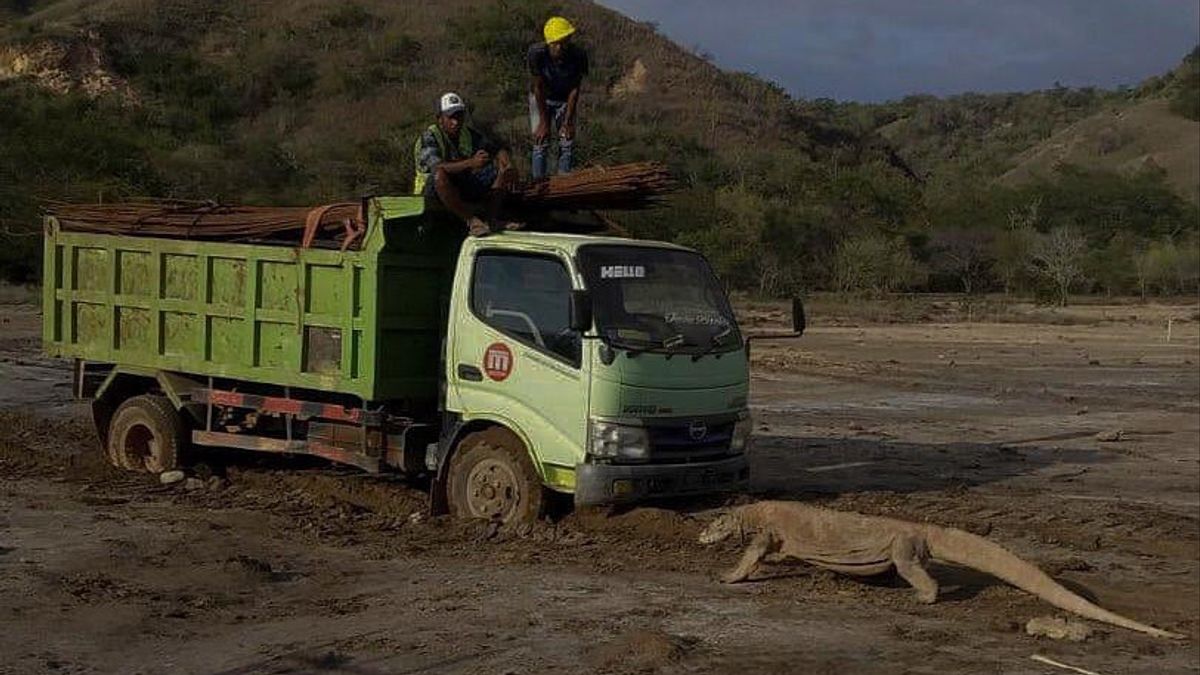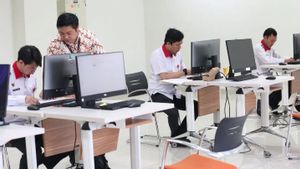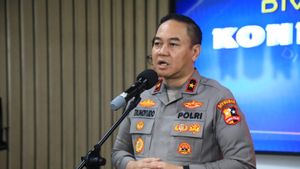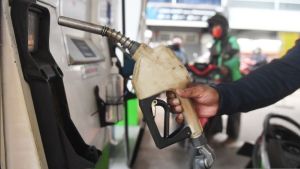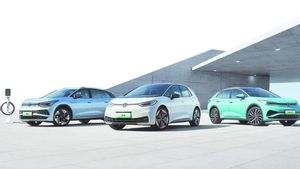JAKARTA - A viral photo shows a Komodo dragon facing a truck carrying construction materials in Komodo National Park, East Nusa Tenggara (NTT). All are aware that the habitat of the Komodo dragon is threatened. But not everyone is willing to realize that the Jurassic Park project on Rinca Island is one of the government's most inconsiderate projects. In fact, it is clear that in history, Komodo National Park was established for conservation purposes, not investment.
The construction material on the back of the truck is the 'seed for building' Jurassic Park. The Komodo dragons in front of the truck are residents who are aware that their residence will be taken and destroyed. There is no need for a reptile language translator to interpret the photo. All one voice, this development is a threat to the Komodo dragon. The destructive power of the project can be felt even today.
Twitter account @awanBaikKomodo wrote: Sad! Komodo face to face with the 'Jurassic Park' tourist building project truck on Rinca Island. For the first time, these Komodo dragons heard the roar of car engines and inhaled the smell of smoke. What will the future impact of these projects be? Does anyone still care about conservation?
Sad! Komodo faced off with a Jurassic Tourism building project truck on Rinca Island. It was the first time that Komodo2 heard the roar of car engines and smelled the smoke. What will the future impact of these projects be? Does anyone still care about conservation? (Photo supplied) pic.twitter.com/ph7Ulj7lnA
- Save Komodo Now (@KawanBaikKomodo) October 23, 2020
Previously, the photo was uploaded first by the Instagram account @gregoriusafioma. Some of the emphasis he put forward in the photo description. "This is totally crazy ..." he said. "... they don't realize that this region has gone through a very long history and involved narratives of sacrifice from various parties," he added. "Jokowi himself may not understand much about Komodo dragon conservation if he only relies on one or two visits."
The narratives above are not exaggerated. This Jurassic Park project is just crazy. Deputy Head of the Advocacy Department for the Indonesian Forum for the Environment (WALHI), National Executive Edo Rakhman, even called the project initiated by President Joko Widodo (Jokowi) as a brutal and reckless move.
"The fact illustrates that the construction was carried out in a brutal and reckless manner, as if (the government) did not take into account the conditions that occurred. The appearance of the Komodo dragon face to face with the truck shows that their habitat is disturbed, ”said Edo when contacted by VOI, Monday, October 26.
When a rare animal named Latin varanus komodoensis has dared to appear in the midst of many people, even facing a truck - which is not their habit, it means that the habitat of the Komodo dragon is seriously disturbed and threatened, whether in the form of land clearing, noise or because of chains. Komodo dragon food has been cut off. So, there is no other interpretation that what is currently happening on Rinca Island is a picture of government intervention in the Komodo dragon ecosystem.
In addition, this project also threatens the economic growth of local communities that are built based on local customs and wisdom. Exclusive structuring schemes whose management is handed over to the private sector will lead to economic domination or monopoly by investors. In fact, it has been a long time since local residents have earned a living by becoming craftsmen, souvenir entrepreneurs, and homestay service providers.
With all these conditions, there is only one way to restore the ecosystem around Komodo Island or Rinca Island: stop the project. There is no other way, said Edo. "The only way is to stop the project and restore the ecosystem and habitat of Komodo dragons on the island."
The Ministry of Environment and Forestry (KLHK) threw a press release on behalf of the Director General of Conservation of Natural Resources and Ecosystems (KSDAE), KLHK Wiratno. The release explains that Rinca Island has a land area of 200 square kilometers (20 thousand hectares). Meanwhile, the area of the Loh Buaya Valley - which will be the location for the construction of Jurassic Park is 5 square kilometers (500 hectares) or 2.5 percent of the area of Rinca Island.
The release also describes the estimated population of Komodo dragons on Rinca Island in 2019, which is estimated to be 1,300. Meanwhile, the population of dragons in the Loh Buaya Valley is 5 percent of the population on Rinca Island or around 66 individuals. The Ministry of Environment and Forestry said the population of dragons in the Loh Buaya Valley over the past 17 years was relatively stable with a slight increase in the last five years.
"The number of Komodo dragons that often roam around the area of construction of facilities and infrastructure in Loh Buaya is estimated to be less than approximately 15 and the Komodo dragons have sunbathing behavior every morning," said Wiratno, quoted on Sunday, October 25.

The press release from the Ministry of Environment and Forestry also claims that tourism development activities have had little effect on the behavior of the Komodo dragons, in which the dragons have become more courageous or become more avoidant of humans in several findings. Even so, development, said the Ministry of Environment and Forestry, does not affect their ability to survive.
He said, this could be proven by the population trend that remained stable at Loh Buaya tourist sites. The release also said that if it is well controlled and ensures minimal contact between tourists and animals, then tourism activities in its current condition are considered not to endanger the Komodo dragon population.
"During the pandemic, there were ± 150 visitors to Rinca Island per month or 10-15 people per day. In the construction of facilities and infrastructure, protocols have been implemented to prevent the negative impact of the construction of these facilities and infrastructure on Komodo dragons which are supervised by 5–10 rangers. "
Then, what is the role of ranger supervision referred to by the Ministry of LHK? Its job is to check the whereabouts of the Komodo dragons, including under buildings, former buildings, or under trucks carrying materials, according to the release. Until now, the development progress has been running for 30 percent and will be completed in June 2021, both facilities and infrastructure, including the construction of a new pier on Rinca Island. So, what is the explanation by the Ministry of Environment and Forestry regarding the viral photo of the Komodo dragon blocking the truck?
"In relation to the photos spread on social media, it can be explained that the activities of transporting construction materials using heavy equipment are carried out because it is not possible to use human labor. The use of heavy equipment, such as trucks, excavators and others, has been carried out with prudence principles. The facilities that are being built are almost above the previously constructed areas, such as the office building of the national park hall, "Wiratno, in a press release.
History of the Komodo National ParkBased on historical records, the existence of Komodo dragons in Indonesia was originally discovered by a European explorer in 1910. Unfortunately, this explorer did not specifically mention the animal as a Komodo dragon.
He considers the Komodo dragon to be part of a crocodile species with various similarities. Therefore, the explorer then spread the news about the existence of "Crocodile Island" in the Dutch East Indies - as Indonesia was called during the Dutch colonial period.
The news about Crocodile Island spread in the Dutch East Indies. Right after two years of being documented by this European explorer, the Director of the Bogor Zoological Museum Peter Ouwens then conducted research. Through a scientific journal entitled On a Large Varanus Species from an Island of Komodo (1912), Ouwens published the results of his documentation related to Komodo.
The research was very popular. In fact, the Latin name komodo, "varanaus komodeensis" also comes from Ouwens. The increasing popularity of the journal made many world explorers want to go to the Dutch East Indies.

They came specifically to watch these hard skinned animals. One of the explorers who became interested was W. Douglas Burden. Burden even specialized in his exploration in 1926 to Indonesia only to meet the Komodo dragons in person.
From his exploration, Burden brought 12 preserved Komodo dragons and two living dragons. Of the total 14 Komodo dragons brought by Burden from the archipelago, some of them are exhibited at the American Museum of Natural History. From there the term "komodo dragon" spread throughout the world.
After the Burden exploration, more and more European explorers were curious about the Komodo dragon. Especially when the world just understood that the giant lizard is an endemic animal that is only found in Indonesia. After Indonesia's independence, to be precise during the reign of President Soeharto, the Komodo National Park was established in 1980.
"The establishment of this park is aimed at preserving the life of the Komodo dragon and its ecosystem for a long time. There are three locations of protected komodo ecosystems in Komodo National Park. These locations include: on Komodo Island, Rinca Island and Padar Island, "writes in the book Secret Komodo (2010).
Not only that, the Komodo National Park has even stunned the world. Besides getting the title as a UNESCO World Heritage Site in 1991, Komodo National Park has also become part of the 7 Wonder of the World as a world natural heritage in 2011. That is why until now the charm of Komodo dragons continues to attract many tourists to come to NTT.
The English, Chinese, Japanese, Arabic, and French versions are automatically generated by the AI. So there may still be inaccuracies in translating, please always see Indonesian as our main language. (system supported by DigitalSiber.id)
